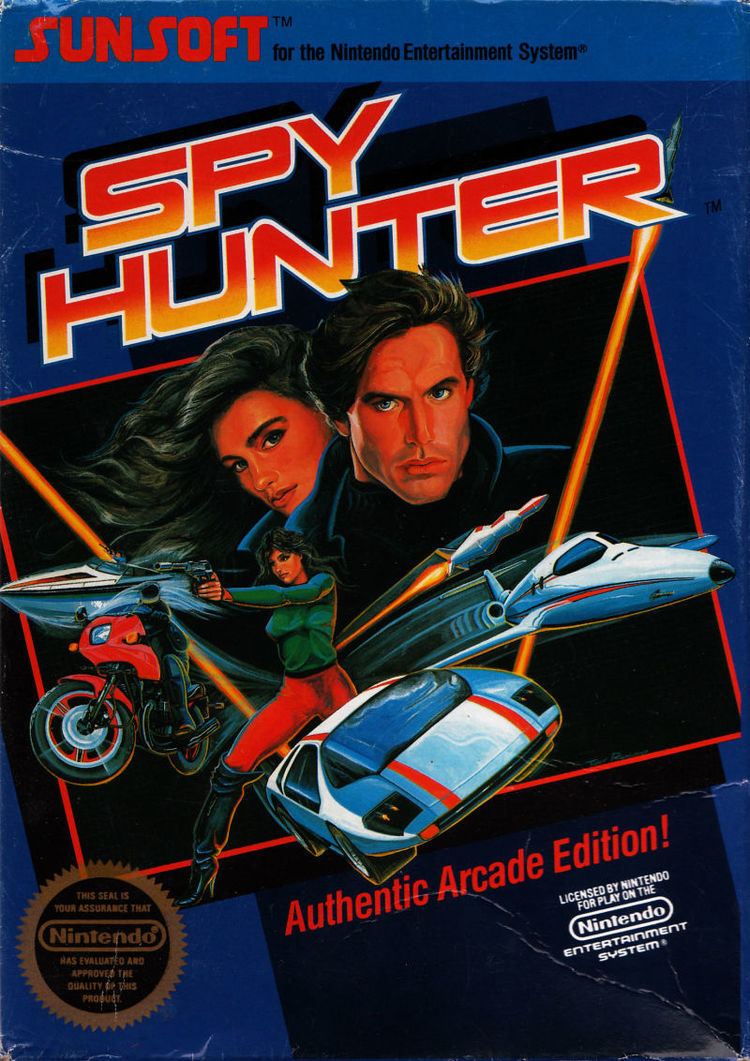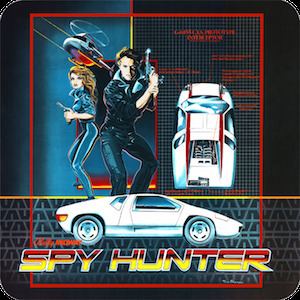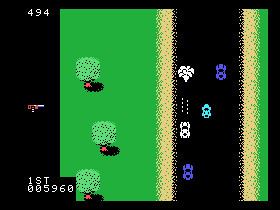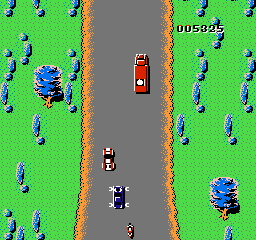Genre(s) Vehicular combat Cabinet Upright, cockpit | Mode(s) Single player Initial release date 1983 | |
 | ||
Display Raster, 480 x 480 pixels (Vertical), 68 colors, 19 inch Wells-Gardner monitor Similar Midway games, Racing video games | ||
Spy Hunter is an overhead view, vehicular combat game developed by Bally Midway and released in arcades in 1983.
Contents
- Arcade game spy hunter 1983 midway
- Gameplay
- Development
- Legacy
- Re releases
- In popular culture
- Film adaptation
- References

The game draws inspiration from the James Bond films and was originally supposed to carry the James Bond license. The object of the game is to drive down roads in the technologically advanced "Interceptor" car and destroy various enemy vehicles with a variety of onboard weapons. Spy Hunter was produced in both sit-down and standard upright versions with the latter being more common. The game's controls consist of a steering wheel in the form of a futuristic aircraft-style yoke with several special-purpose buttons, a two-position stick shift (offering 'low' and 'high' gears), and a pedal used for acceleration.

Spy Hunter was ported to the Atari 2600, Atari 8-bit family, Amstrad CPC, ZX Spectrum, Commodore 64, Apple II, ColecoVision, MS-DOS, Nintendo Entertainment System, and BBC Micro. The NES version was re-titled Super Spy Hunter. Spy Hunter was followed by Spy Hunter II which added a 3D view and two-player split-screen play, a pinball tie-in, and a successor series of games bearing the Spy Hunter name.

Arcade game spy hunter 1983 midway
Gameplay

Spy Hunter is a vertical scrolling driving game with the player in the role of a spy driving an armed sportscar. The object of the game is to travel the freeway destroying as many enemy vehicles as possible while protecting civilian vehicles. The game uses top-down perspective.

The game begins with the player driving the fictitious G-6155 Interceptor, which was based on the Isdera Imperator 108i. Various enemy vehicles try to destroy the player's car or to force it off the road, including a helicopter that drops bombs from overhead. A counter increments the score while the car is moving and on the road. Additional points are earned destroying enemy vehicles using weapons or by forcing them off the road. After an initial lead-in time during which the player has an unlimited supply of cars, the player must earn extra cars by obtaining sufficient points. Destroying non-enemy cars halts the score counter for a short while, and no points are scored whenever the player's car is off the road. The car can be destroyed by a hard collision with another vehicle, if it is hit by an enemy weapon (including the craters blasted into the road by the helicopter's bombs), or by running far enough off the roadway (or waterway).
Following periodic forks in the road, players can enter new regions with different terrain or weather conditions. Players can also augment car's standard machine guns with other weapons by entering the weapons van, which appears in each new territory and can be periodically summoned by pressing the blinking "Weapons Van" button. Three special weapons are available: oil slicks, smoke screens, and surface-to-air missiles. Each has limited ammo and are lost if the player's car is destroyed. The game's dashboard shows which weapons are available, when lit.
It is possible for the player to convert the car into a go-fast boat for brief periods by driving through a special boathouse which appears infrequently at the side of the road after which the player is attacked by two different enemy boats.
The in-game road is endless and the game itself has no ending.
Development
Game designer George Gomez drew inspiration for the game from listening to an audio cassette tape of music from James Bond films. He designed the game with Tom Leon, with whom he had worked on TRON. Gomez sketched out the in-game road map on a long scroll of drawing paper and also came up with the idea of the weapons van. Originally the game was to be based directly on James Bond and have the James Bond theme as in-game music, but the license could not be acquired. Instead, an electronic arrangement of Henry Mancini's theme to Peter Gunn plays throughout.
Legacy
Following the success of the arcade version of Spy Hunter, a pinball version of the game was released in 1984 by Bally. The original Spy Hunter was followed by an arcade sequel, Spy Hunter II in 1987. It retained the Peter Gunn music and incorporated a cooperative two-player mode, but the top-down view was replaced with a more 3D perspective from behind and above the car. The game achieved little success and remained largely unknown as it never went into large scale production.
After Japanese video game developer Sunsoft reprogrammed the original arcade game for the Nintendo Entertainment System, Sunsoft later created Battle Formula, featuring very similar gameplay, but to avoid copyright infringement outside Japan and to understand the point of the game only by its front cover, Sunsoft America signed a deal with Bally Midway in adding it to the Spy Hunter series by releasing it outside Japan as Super Spy Hunter.
Spy Hunter itself is regarded as one of the "Top 100 Videogames" of all time by the Killer List of Videogames (KLOV).
The series was reprised with the 2001 game SpyHunter which was developed by Paradigm Entertainment and released by Midway Games for the PlayStation 2, Xbox and GameCube, Game Boy Advance and Microsoft Windows platforms. The game marked a shift towards mission-based gameplay, and featured vehicles that switched seamlessly between land and sea. A sequel developed by Angel Studios was released in 2003. Another reboot of the series was developed by TT Fusion for the Nintendo 3DS and PlayStation Vita and released by Warner Bros. Interactive in October 2012.
Re-releases
Spy Hunter was included in Midway's Greatest Arcade Hits: Volume 1 for Nintendo 64; Midway Arcade Treasures, a 2003 compilation of arcade games available for the GameCube, PlayStation 2 and Xbox consoles; Midway Arcade Treasures: Extended Play for PlayStation Portable; and Midway Arcade Origins, a 2012 compilation available for PlayStation 3 and Xbox 360.
Spy Hunter was cloned as Major Motion, released by Microdeal for the Atari ST and Amiga in 1986.
In popular culture
Film adaptation
In the summer of 2003, Universal Pictures acquired the rights to the 1983 arcade game Spy Hunter from Midway Games. The following September, Universal signed actor Dwayne "The Rock" Johnson to star in the film adaptation based on the game. Screenwriters Michael Brandt and Derek Haas were hired to write the screenplay, though a director had not been decided at the time. Spy Hunter was slated to begin its budgeted $90 million production in spring 2004 in time for a summer 2005 release. In January 2004, screenwriters Mark Swift and Damian Shannon replaced the original writing duo to rewrite the script, with production slated for June. By May, Universal Pictures acquired director John Woo to helm the project. In the same month, the previous screenwriters were replaced by screenwriter Zak Penn to rewrite the script once more. By August 2004, production had been delayed, pushing Spy Hunter back to be released in summer 2006. In April 2005, Penn was replaced by screenwriter Stuart Beattie to rewrite the script. By May 2005, however, director John Woo left the project due to scheduling conflicts. In August 2005, Dwayne Johnson said the film was still developing without a director. Pre-production work was underway with designs such as the morphing Interceptor vehicle driven by Alex Decker. Production was eventually halted for the time being, and Dwayne Johnson was detached from the project.
In May 2007, Paul W. S. Anderson was hired to replace Woo as the director. He was going to be writing a new script with another screenwriter. He left the project a year later due to his commitment to Death Race 2 as a producer. In February 2013, however, Warner Bros., who owns the rights to the film adaptation distribution, announced that Ruben Fleischer was officially brought on board to direct, after several rumors were given to the public ears, with Carter Blanchard providing the script, bearing an entirely rewritten storyline. In November 2015, news were made that Blanchard was replaced with new pair of writers, Neal Greaves and Sam Chalsen, with Dan Lin and Roy Lee producing the film, while the report also made it unclear whether Fleischer was still on board as the director.
